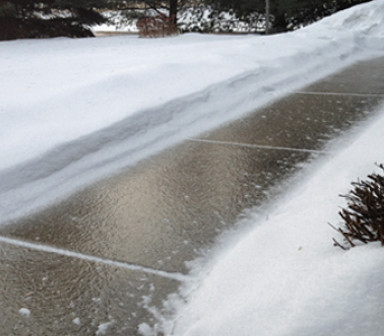Winter weather can often present challenging and, at times, dangerous conditions for people who have a visual impairment.
In this article, Sight Scotland Veterans Rehabilitation Officer, Katrina, gives her tips for people with sight loss to stay safe and maintain independence while out and about this winter.

Dealing with glare
Glare can prove a particular problem in winter for people with sight loss because the sun is low in the sky during the morning and late afternoon. There is an additional chance of glare if the sun reflects off snow, ice and water on the road.
There are simple solutions that can help with this issue, such as wearing a brimmed or skip hat and wearing anti-glare shields which cut out the blue light.
Anti-glare shields come in various colours and styles. If you need help selecting something that's right for you, reach out to us on our Support Line for advice on getting the correct colour to suit you.
Dealing with the dark
Darkness comes with winter’s shorter days. This can, of course, be a problem for many people, but especially for those who have a visual impairment. It can be even more especially difficult for people with retinitis pigmentosa (RP), who experience night blindness due to loss of peripheral vision as a result of the condition.
If your vision is reduced further by the dark, we recommend that you carry a symbol or guide cane when you’re out and about. These canes are small enough to fit into a pocket or handbag, so they can be easily brought out when needed. They are also reflective and will help to make any fellow pedestrians or passengers and drivers aware that you have sight loss.
If you need advice about using a long cane or training in its use to enhance your safety and mobility skills, then get in touch with our Support Line.
It may also be helpful to carry a small torch to help to provide additional light, especially in unfamiliar areas and for tasks like looking at bus timetables.
Visibility
It’s extremely important to be visible to drivers, especially during the dark winter months. To ensure that drivers can easily see you, we recommend wearing brightly coloured outerwear that stands out, or consider adding a reflective item to give drivers more warning by the roadside and as you cross roads.
You could also consider wearing a high-visibility vest, sash or armbands to make yourself more visible. These are often utilised by cyclists in all weather conditions, so are fairly common.
Sounds and echoes
The arrival of snow can bring added challenges. Sounds or echoes that can normally be helpful for orientating around surroundings may be muffled, and it can make it harder to hear the sounds of cars or cyclists.
We recommend wearing a beanie-style hat which can be folded above the ears, so as not to impede auditory clues further.
Mobility cane use in the cold
If you’re using a long cane in cold winter weather, we recommend wearing leather or vegan/faux leather (sometimes called pleather) gloves rather than woollen gloves. This is because woollen gloves can be so thick that they reduce your ability to pick up changes in surface texture through your cane. Alternatively, you could also wear a golf club cover over your hand which will enable the wearer to hold the cane in the usual way.
A light cane touch is recommended for fluffy snow and a heavier touch for icy conditions. Poking through the snow with the cane to gauge its depth and consistency is a useful practice before setting out.
Using the inner edge (or ‘shoreline) of a path, where there is one, should make travelling through snow easier as it gives you a line of travel and can prevent you from unintentionally walking onto the road where the snow has covered the kerb edge.
Further advice and support
Do you have a loved one with sight loss?
If you're seeking some advice and support, we can help.
Contact our Support Line or call us on 0800 024 8973 to speak to our friendly Sight Scotland experts.